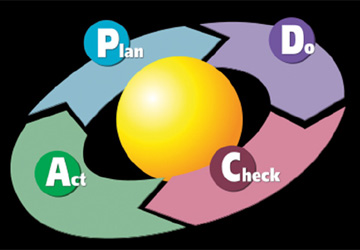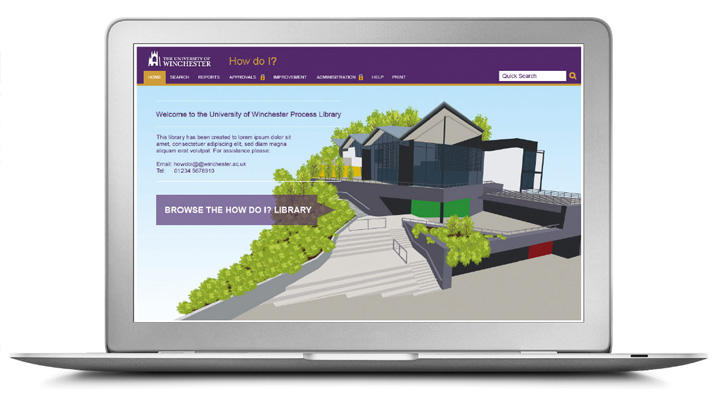University of Winchester
Winchester's Journey, Excellence to Lean

The University of Winchester was originally founded in 1840 as a Church of England foundation for the training of elementary schoolmasters. Growing considerably over the years, it became a General College of Higher Education in 1990 and was awarded University status in 2005.
Also in 2005 a new Vice-Chancellor was appointed who, recognising the need for the University to transform itself into a business, decided that Winchester should get back to basics using the EFQM Excellence model.

Early on it became obvious that their processes were letting them down. The four faculties all claiming that they each needed different processes and the academics not liking to think of their students as 'customers' - felt to be a dreaded word!
Their process problems, although not too bad, could be summarised as follows:
- University wide
- Bureaucratic
- Time consuming
- Too paper based, with not enough online
- Unclear - for both staff and students
- Having too much variation (both between and within faculties)
- Causing too much time and effort to be spent correcting errors
- All giving rise to the possibility of a poor student experience
The University of Winchester implemented a major continual process improvement initiative with the Triaster Solution in 2013 and quickly jumped 27 places in the national student satisfaction survey. In 2015 we are now fourth in the country (out of 162.)
Claire Lorrain, University of Winchester
These gave the University of Winchester a variety of problems, the most pressing of which were believed to be:
- Their systems had grown like topsy and were not felt to be fit for the future
- There was a large and growing disparity between and within Faculties
- Pressures on staffing were increasing and with it the need to get data right first time, cutting out duplication of effort
- Individualised student data had become increasingly important for funding and statutory reporting
- HEFCE required audit of data returns and imposed hefty fines if incorrect
- Student attendance monitoring exemplified problems
- There was a need to move to an integrated timetabling system
- A good student experience had become essential in a changing market place
In 2010 Claire Lorrain was appointed as Organisational Development Officer and the University purchased the Triaster Solution. The University's AS-IS key processes were quickly mapped and the resulting process maps used to show senior management where processes were breaking down.
In 2011 Winchester achieved the top award of 5 stars in the EFQM assessment 'Recognised for Excellence'. Although a great result, one of the key outcomes of the assessment was to question what are the University's key processes and how can these be improved?
The response was an initiative to improve Winchester's processes by taking a Lean approach, which Claire has summarised as:
A philosophy of work based on application of two principles:
1. Respect for people
Remembering staff are our greatest asset. It is they who know what works well and what needs to be improved, and who have the ability to suggest and make the necessary improvements.
2. Continuous improvement
Continuously looking at our work processes and striving to improve them.

This fed directly into the following process mapping objectives:
- To maximize customer (student and other staff) value in the process, minimizing waste. Creating more value for the customer with the same/fewer resources
- To reduce work pressures on staff and/or free up time for other work
- Not to reduce staffing
- Understanding of 'customer value' and to focus key processes on continuously increasing it
- To change management focus from optimizing separate IT systems, staffing, departments etc to optimizing the process that flows horizontally across them
- To eliminate waste along the entire process to reduce staff time and effort
In 2011 the University of Winchester went live with their Triaster Process Library, making it accessible to all staff and students and with a lot of forms accessible only through the Library (for example expense claim forms and concession application forms) to ensure that everyone got used to using it.
As students and their parents now routinely 'compare the market' when choosing a University, results in student satisfaction surveys are crucial. Accordingly they prioritised improving some key processes which impacted the student experience, with student satisfaction a key driver:
- Student recruitment
- Enrolment. (This used to take from the Sunday when students first arrived, until Wednesday (4 days) but now takes 25 minutes for each student.)
- The capture and storing of data on SITS (a student record management system) and extraction for use in other core systems; to ensure completeness and accuracy in the most efficient way possible
- Module selection
- Programme transfers
- Module transfers
- Examination and other assessment processes
- Graduation
- Billing
Following the implementation of improvements for these key process, Winchester jumped 27 places in the 2013 national student satisfaction survey. In addition as well as again achieving 5 stars in their EFQM assessment, they achieved a greatly improved point's score.
Over the course of the (to date) 32 Continuous Improvement projects across the University of Winchester considerable savings have been achieved, which have been re-invested in service provision. This is enabling the University to respond to the increased student expectations arising from the increase in the fees that they are paying, whilst responding to the overall reduction in funding. It also means staff view process improvement very positively, engaging actively and requesting focus on areas they highlight as needing attention.
Ownership of the processes is always given to the staff on the front line - the ones delivering the process who know it best. About 60 staff have been trained to process map, some responding better to mapping in Triaster whilst others, such as finance staff and academics, respond better to data exported to Microsoft Excel. This has really helped to embed the transition to Lean and meant that improvements are adopted readily and positively.
In addition the process improvement team has the authority to make minor changes without going through Committee (which takes about 6 months) and can get things done very quickly. Again encouraging staff to engage with them.
The improvement team at the University of Winchester approach process improvement as follows:
- Always beginning with a clear objective
- The current process (AS-IS) is captured using the Triaster process mapping tool
- The mapped process is published to their Process Library where it is reviewed and approved
- Bottlenecks are highlighted
- Options for alternative processes are identified and analysed and the future (To-Be) process is modelled. This may incorporate for example the use of new technology or perhaps just a few small changes
- An Action plan for implementation is formulated
- The project team presents the proposed process to management and colleagues
- The new process is agreed and implemented
- Short follow-up events are held typically held at 15, 30, 60, 90 days and at one year to embed the new process as business as usual and review the return on investment.
Examples of process improvements introduced are as follows:
The procedure for cancelling a lecture has been considerably streamlined. It had been 'a minefield', with no-one knowing who was responsible. It took 3 weeks for responsibilities to be agreed, but these are now clear and accessible in the Process Library.
The car parking policy, which had originally been written by an academic and was 39 pages of text, has been so simplified - that it can be captured on just one process map.


The process for Open Days has been made far more efficient, by the introduction of QR codes and iPads to scan them. This has enabled the number of staff needed to register open day visitors to be reduced from six to just one, and they are now able to focus on greeting the visitors (rather than finding their name on a list). This improved process also enables the automatic sending of a follow-up e-mail to all registrants who attend and a different one to those registrants who don't attend on the day.
A pre-populated on-line form, introduced for the research submission that each member of the academic staff is required to make each year, is very popular and saves at least a couple of hours' time for each submission over the previous system, where they needed to complete a word form.
In 2015 having reviewed how the staff and students were using Winchester's Process Library, it has been restructured to create three Libraries as follows:
- How do I? - for staff
- Operations
- How do I? - for students
This aligns with the University’s objective of trying to make the student journey the best possible experience and it is certainly working.
After jumping 27 places in the 2013 National Student Satisfaction survey, in 2014, the University of Winchester were in the top 20 (out of the 162 universities in England) for overall student satisfaction and in 2015 the University of Winchester ranked fourth.
..and in 2016, they won both the BQF Sustainable Future Achievement Award and the UK Excellence Award.
Published November 2015







